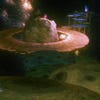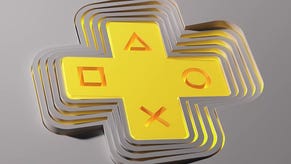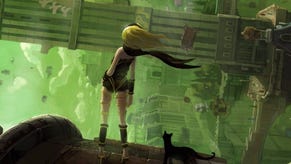Gravity Rush Review
Found in translation.
The only thing that's changed is the translation, but Gravity Daze felt ever so slightly different on my second play-through. For starters, the game's called Gravity Rush now that it's reached the UK (or is about to - it's released on 13th June). On top of that, I mostly knew what was going on this time around.
That's because for my initial review, I played the Japanese version, and I can't speak/read/in-any-way-understand Japanese. I could follow the visual mission prompts and fumble my way through the levelling screens, but the plot was largely the stuff of mystery, the characters were little more than passing faces, and the dialogue was just pleasant sound playing in my ears.
I now know that the story's about a girl named Kat and a cat named Dusty, and I know that Dusty's some sort of magical cat, and Kat's some sort of magical girl, blessed with the ability to alter gravity at her will, blasting herself from sidewalk to rooftop to the grim slope of a church steeple as she explores the gorgeously warped city of Hekseville and gives monsters a good shoeing.
I picked up quite a bit of this the first time around, of course, but I now get the details as well as the broad-stroke stuff. I know that Kat's called a Shifter on account of her magical powers, that people are tentatively afraid of her at first, and that those weird gooey beasts attacking the floating, endlessly curlicued metropolis she's found herself in are called Nevi. They're something to do with a gravity storm that is slowly tearing the place to pieces.
More importantly, I know that the narrative that unfolds from this point onwards rarely bogs itself down in gloomy portent and heroic misery: it's playful, knockabout fun for most of the game, filled with witty intrigue and oddball detailing. It's lightly handled and easygoing, aside from the very occasional downer moment, and I don't think I was really expecting that at all.
The tone is a good fit. A more serious approach to the storyline would have crushed a game as delicately weird as this; a breezy touch was needed to complement Gravity Rush's headlong toing and froing, its ceaseless dashing and lunging.
Kat may be an amnesiac, but she's not particularly tortured about her plight for much of the game. She's flirty, lively, and eager to explore her surroundings, actually, switching between giddy cheerfulness and pouty teenage sulks at the flick of a switch. She doesn't want to talk much about the fate of the world she's been summoned to save. She wants to talk about boyfriends, and she greets the more confusing twists of the rather rambling plot with the same wry surprise that players will.
Kat's quirky personality brings yet more life to the game's wonderful Moebius-inspired cut-scene comics, too, while the decision to stick with the original Japanese voices and lead with subtitles means the adventure retains a little of its sophistication and mystery. In some ways, Kat's a bit of a valley girl. If she actually sounded like one, however, I'm not sure it would have worked.
Unhurried plotting, sweet-natured characterisations and smart dialogue aren't the only surprises. On my second play-through I also spotted a few mechanical things I missed the first time. It's nice to fully understand the levelling options, for example, even if, between health bar or gravity-flipping extensions and powering up a handful of specials, there's nothing truly mind-blowing lurking within the customisation menus.
It's nice to discover a dodge move to add to the arsenal of gravity kicks and roundhouses - it's triggered by a swipe of the screen, though, which meant I then almost never remembered to use it. Second time around, I also realised Kat can change costumes back at her little house, and that the events that unfold from one mission to the next (even in English, it's a very episodic game, moving sideways as often as forward, with the weekly-instalments feel of one of the earlier Tintin stories) see her reputation in Hekseville gradually improving, boosting her maximum stats as it goes.
More important than the new stuff, however, is the existing stuff. A chance to play through the game afresh left me just as excited by what Sony Japan's come up with as I was the first time around, even when the whole thing's been separated from the new-car smell of the early days of Vita. Gravity Rush's mission structure may not be all that special - it's basically follow the waypoint, collect this, fight that - but the place you're exploring definitely is, and the way you get around that place is even better still.
This is a game designed, I suspect, with a niche kind of dandyish adventurer in mind. It offers an art nouveau world set to Django-ish jazz and militaristic flourishes, in which you weave between well-to-do flâneurs as you move from one geometrical plane to the next, beating up anything that comes with tendrils attached as you do so. You can't open many doors in Hekseville, but the game would never work inside anyway. Instead, it's about using your superhero powers to fling yourself across boiling skies and tumbling clouds, choosing when to make a wall into the floor and when to walk across the underside of a building or a mushroom just because you can.
All of this is achieved with an astonishing absence of fuss: one squeeze of the trigger sets you floating, and then you choose a target, squeeze the trigger again and the game handles everything else. Whenever you start to grow disoriented, a quick look at your scarf or your dangling hair will always remind you which way is actually up and which way is down. True Up and True Down? We need more games like this.
Explore, meanwhile, and you'll find gems (to spend on levelling) by the glittering hundreds, and you'll also trigger bonus challenges to add a bit of variety. On top of that, you can chat to highlighted pedestrians, who will then tell you a little more about the city you've become trapped in. There's a surprising depth of detailing to Hekseville, and the names of its various districts - Vendecentre, Auldnoir, Endestria - all sound wonderfully appropriate, conjuring images of stained-glass excess, chuntering steampunk engines and clanking pre-war European automobiles. (Just me?)
Occasionally, you'll be tasked with going into truly fantastical spaces known as rift plains in order to bring back missing districts or neighbourhoods that have been torn away by the Nevi. Here, the architecture gets really weird: luminous, organic, uncommonly dreamlike. You have to see it for yourself, really. Why wouldn't you want to? It's architecture that's swallowed some other architecture. Who knows what it will do next? It's at least going to burp up a chimney.
Throughout the game, combat remains simple but satisfying - there's brawling to be done when you're on the ground, while your main attack in the air is a gravity kick, which works as you lock onto a target and then rush in, foot first. The gravity kick's rather soft lock may annoy some players, since you can end up missing your target if it moves at the last second, but the system encourages you to strategise gently as you zoom around.
You steadily unearth a selection of special mega-damage attacks as you play to use when all else fails. You earn the odd new means of getting around, too, like a gravity slide that sees you putting both thumbs on the screen and steering with tilt. Why not? Then there are bosses, of course: gloopy bulges of oil and hot glass forming a variety of nasty shapes. Fighting them doesn't call for too much finesse, but the ensuing battles revel in a lovely sense of shattering impact all the same.
Really, though, this is largely about the thrill of zipping through the sky, spotting a distant building, and wondering what Sony's magpie artists have put up there for you to find. Kat may be a superhero, but it's telling that she spends a lot of her time behaving as a tourist. Hekseville's a great place for a holiday, in other words, and Gravity Rush makes for a wonderful return ticket. All aboard?













